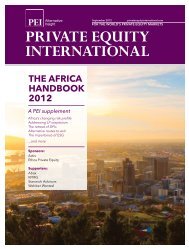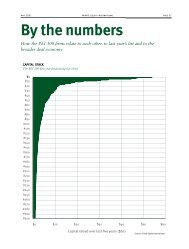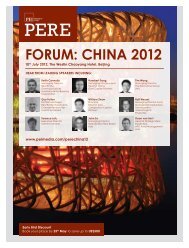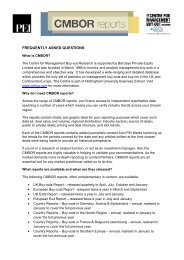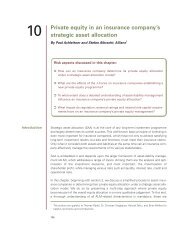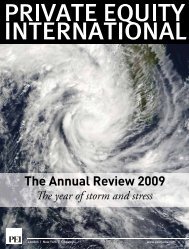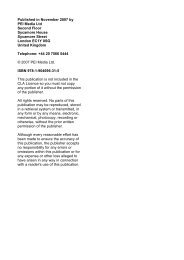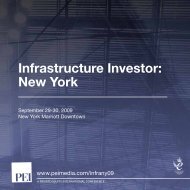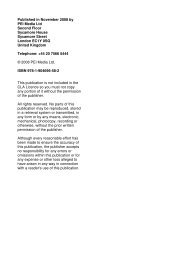THE ANNUAL REVIEW 2010 - PEI Media
THE ANNUAL REVIEW 2010 - PEI Media
THE ANNUAL REVIEW 2010 - PEI Media
You also want an ePaper? Increase the reach of your titles
YUMPU automatically turns print PDFs into web optimized ePapers that Google loves.
private equity annual review <strong>2010</strong> pa g e 111<br />
c h i n a<br />
Banner year<br />
As fundraising in RMB continued to dominate in China in <strong>2010</strong>, the country’s offshore<br />
LPs have been feeling increasingly marginalised, finds Hsiang-Ching Tseng<br />
One of the key statistics to come out of<br />
China in 2009 was the fact that at $8.73<br />
billion, fundraising for RMB-denominated<br />
China-focused private equity funds overtook<br />
funds raised in USD ($4.27 billion) for the<br />
first time, according to China-focused private<br />
equity research body Zero2IPO.<br />
Despite a recovery in Western LPs’<br />
appetite for private equity commitments<br />
(especially to China), the trend looks to<br />
have continued into <strong>2010</strong>. In fact, the ranks<br />
of Chinese LPs are set to be swelled even<br />
further going forward since in August <strong>2010</strong><br />
China’s Insurance Regulatory Commission<br />
finally gave Chinese insurance companies the<br />
green light to invest in private equity. Though<br />
investment into the asset class is capped at no<br />
more than 5 percent of their last quarter’s<br />
total assets, the new rules mean as much<br />
as RMB226 billion (€26.2 billion; $33.2<br />
billion) could enter China’s private equity<br />
market, based on total Chinese insurance<br />
industry assets of RMB4.52 trillion at the<br />
end of June.<br />
But as spending power and funds raised in<br />
RMB have increased, so too has the feeling<br />
of marginalisation from offshore LPs who<br />
have invested in China-focused USD funds<br />
with prominent local managers managing<br />
both types of fund.<br />
In a country which has one (very strict)<br />
rule for the investment of foreign money,<br />
and another (much laxer) one for local<br />
money, it is not hard to see how conflict can<br />
arise. The LP Association of China (LAPCN),<br />
which was formed three years ago by LPs<br />
such as Pantheon, Morgan Creek Capital<br />
Management and Adam Street Partners,<br />
has identified four principle areas where<br />
conflicts of interest have arisen: deal<br />
allocation; resource allocation; timing of<br />
successor funds; and economic incentives.<br />
And given the opacity of investment in<br />
Huang: RMB funding is the future in China<br />
“We have to wake up<br />
to the reality that the<br />
RMB funding source is<br />
the future in China and<br />
returns from RMB funds<br />
are likely to be better<br />
in the near future”<br />
China, LPs feel they have no real way of<br />
knowing how much manager discretion is<br />
playing a role when it comes to choosing<br />
between their USD and RMB pools.<br />
“GPs say if it’s a restricted industry then<br />
we’ll use RMB – ok I’ll buy that. Or they’ll<br />
say the entrepreneur only wants RMB – but<br />
how do you know for sure? You have to take<br />
the GP’s word for it – it’s not practical for<br />
LPs to be checking up on every deal. So you<br />
always wonder... maybe that deal could have<br />
been done in USD?” explains Jason Zhang, a<br />
Beijing-based managing director at Morgan<br />
Creek Capital Management.<br />
Despite the strain this conflict has placed<br />
on many GP-LP relationships, offshore LPs<br />
acknowledge that the growth of China’s<br />
RMB industry is not only unstoppable, but<br />
natural.<br />
“For all these years, private equity in<br />
China has meant Chinese GPs managing<br />
USD funds,” reflects Vincent Huang, a Hong<br />
Kong-based partner at Pantheon. “We have<br />
to wake up to the reality that the RMB<br />
funding source is the future in China and<br />
returns from RMB funds are likely to be<br />
better in the near future. We cannot change<br />
this; we can at best try to align interests<br />
with the GPs.”<br />
The ultimate solution would be for the<br />
government to scrap Circular 142, a 2008<br />
law from the State Administration of Foreign<br />
Exchange which restricts the conversion<br />
of foreign currency for the purposes of<br />
investment, allowing foreign and domestic<br />
LPs alike to invest into the same fund.<br />
And in October, it seemed that Shanghai<br />
had come close to doing just this when<br />
it announced it had gained in-principle<br />
approval from China’s financial authorities<br />
to launch a Qualified Foreign LP (QFLP)<br />
programme.<br />
Similar to the Qualified Foreign<br />
Institutional Investor scheme already in<br />
existence, which allows approved foreign<br />
investors access to Chinese equities, the<br />
broad aim of the QFLP would be to allow<br />
approved foreign LPs access to the domestic<br />
private equity industry.<br />
However, although a cautious welcome<br />
was expressed by China’s foreign LP<br />
community, wholesale celebrations have yet<br />
to be seen as much of the detail around the<br />
QFLP scheme still needed to be clarified. n




